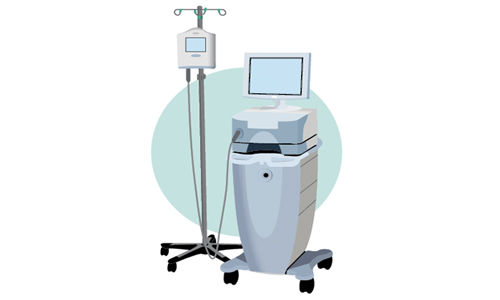Johnson & Johnson’s Sedasys: Know your audience
J&J’s Sedasys device was a computerized sedation and anesthesia system that aimed to disrupt the field of anesthesia by removing the need for a highly trained anesthesiologist during routine colonoscopies.
The system won FDA approval in 2013 after an initial rejection in 2010 and some subsequent back-and-forth with the federal safety watchdog. Johnson & Johnson touted the device’s ability to reduce oversedation and improve recovery rates – and, importantly, substantially reduce the cost of patient sedation to around $200 per procedure, about a 10th of what it would take to pay a fully trained anesthesiologist.
But the device failed to gain traction and was discontinued in March last year, only 3 years after it was approved and only a year into its launch. Sales were modest at best, with only a handful of providers adopting the system. (Johnson & Johnson media relations did not respond to a request for comment about Sedasys.)
The device ended up facing a major hurdle outside of regulatory issues – opposition from the anesthesiologists J&J had targeted as customers.
The Washington Post published an article in May 2015 touting Sedasys as a “new machine that could one day replace anesthesiologists,” quoting an anesthesiologist as saying, “That’s going to replace me.”
That threat did not go unheard. The American College of Anesthesiologists and the American Society of Anesthesiologists lobbied against Sedasys during its early development, claiming anesthesia was too delicate and sensitive to trust to a system.
Both groups would eventually back the device, but only after Johnson & Johnson modified its ambitions. Indications would require an anesthesiology doctor or other operator to be on call and limit the device to simple procedures such as colonoscopies and endoscopies, significantly narrowing its usefulness.
“The most common area that we see these things fail is not fully understanding and addressing the needs of the user or not even understanding who the actual user of the device is,” KraMer said. “There are other people involved who could be considered ‘users,’ all the way down to the purchasing person who buys the equipment.”
Although the device appealed to hospital managers and bean-counters, it didn’t sit well with anesthesiologists, who require an additional 4 years of training after medical school.
Many companies end up developing new, novel and sometimes groundbreaking technology without spending enough time considering the users’ specific needs, KraMer said. And without that consideration, people are hesitant to adopt a new technology – especially if they see it as a threat to their practice.
“If It doesn’t fit into their practice, it’s not reasonable for them to use,” KraMer added. “Those things are often ignored for the sake of a flashy technology.”
Early opposition, a narrow scope and a lack of knowledge of the user base may have contributed to Sedasys being pulled from the market. Other devices end up in the bin for different reasons – and with much more severe results.






There are very few ideas so good that they can survive being poorly executed. In addition there are a whole lot of folks who can speak very convincingly while being quite devoid of correct information.
Given that combination it is quite possible to launch a terrible disaster.
The basic concept behind Theranos looks like a great idea, and possibly it could still be a great product if no mistakes or shortcuts led the development astray. OR the reputation may be so very damaged that it will not ever happen. I don’t have enough data to say.
Given the reliability of computer controls and common operating systems who, being aware of that track record, would possibly trust a computerized anesthesiologist. Certainly not this experienced engineer.
It is certainly useful to be able to learn from the errors of others without having to suffer the same pain as they did. It is not a “finger pointing” thing to choose to study what went wrong, it is, much rather, an attempt at “learning from history”, since those who don’t learn from past mistakes are doomed to repeat them again.
Thanks, William! Those are really good points. Hope you found the article useful.